Exploring HRM Problems & Solutions for Staff in the Mining Industry
VerifiedAdded on 2023/06/11
|13
|3659
|357
Essay
AI Summary
This essay delves into the human resource management challenges prevalent in the mining sector, specifically addressing the difficulties in attracting and retaining employees. It identifies key issues such as unsafe working conditions, low compensation, limited growth prospects, and weak leadership as primary reasons for these problems. The essay then proposes several strategies to improve the situation, including focusing on organizational fit during recruitment, implementing robust safety measures, establishing talent management programs, promoting work-life balance, providing comprehensive medical aid, fostering peer support, and offering competitive compensation with recognition for achievements. The analysis concludes that by adopting these strategies, mining companies can create a more attractive and supportive work environment, leading to improved employee retention and overall organizational success. Desklib provides access to similar essays and study tools for students.
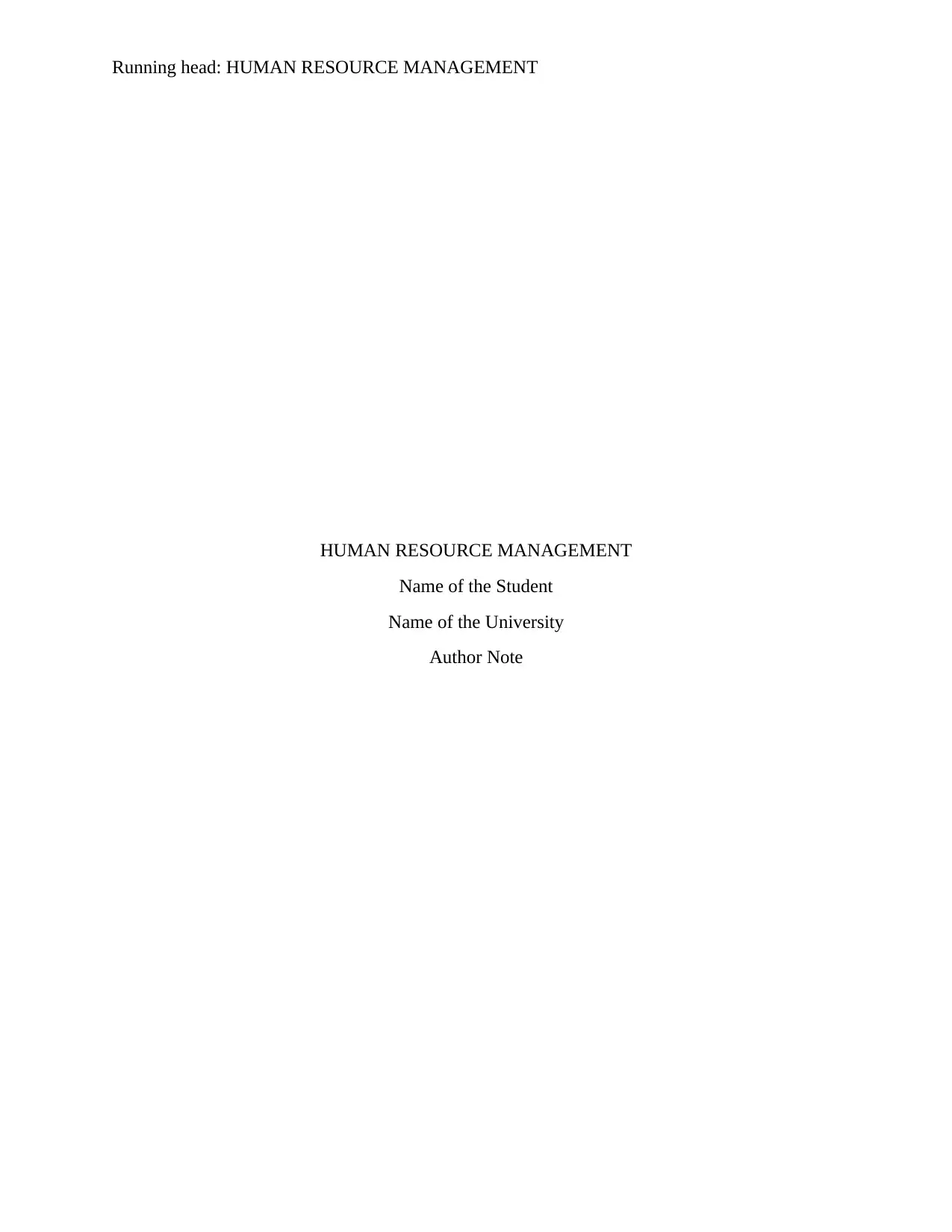
Running head: HUMAN RESOURCE MANAGEMENT
HUMAN RESOURCE MANAGEMENT
Name of the Student
Name of the University
Author Note
HUMAN RESOURCE MANAGEMENT
Name of the Student
Name of the University
Author Note
Paraphrase This Document
Need a fresh take? Get an instant paraphrase of this document with our AI Paraphraser
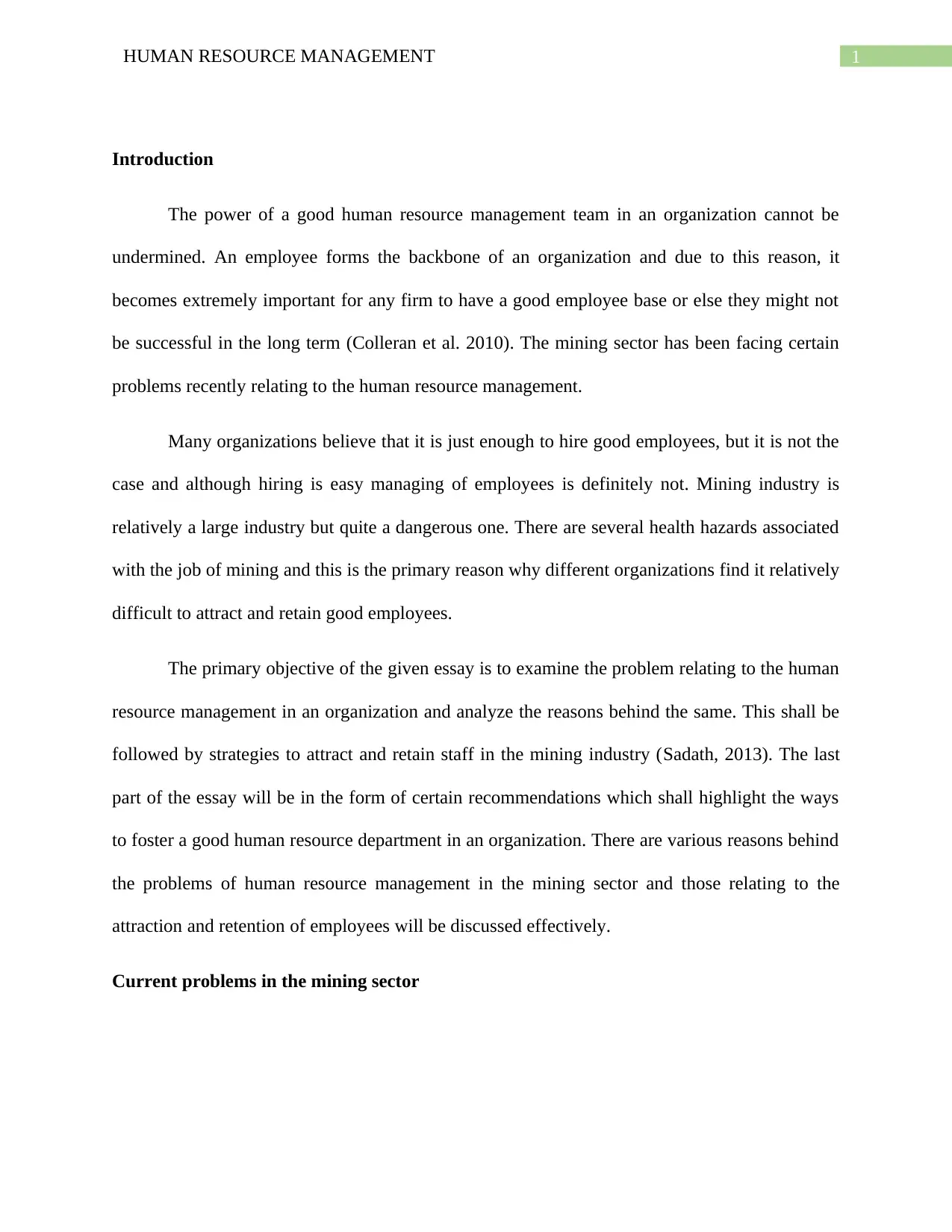
1HUMAN RESOURCE MANAGEMENT
Introduction
The power of a good human resource management team in an organization cannot be
undermined. An employee forms the backbone of an organization and due to this reason, it
becomes extremely important for any firm to have a good employee base or else they might not
be successful in the long term (Colleran et al. 2010). The mining sector has been facing certain
problems recently relating to the human resource management.
Many organizations believe that it is just enough to hire good employees, but it is not the
case and although hiring is easy managing of employees is definitely not. Mining industry is
relatively a large industry but quite a dangerous one. There are several health hazards associated
with the job of mining and this is the primary reason why different organizations find it relatively
difficult to attract and retain good employees.
The primary objective of the given essay is to examine the problem relating to the human
resource management in an organization and analyze the reasons behind the same. This shall be
followed by strategies to attract and retain staff in the mining industry (Sadath, 2013). The last
part of the essay will be in the form of certain recommendations which shall highlight the ways
to foster a good human resource department in an organization. There are various reasons behind
the problems of human resource management in the mining sector and those relating to the
attraction and retention of employees will be discussed effectively.
Current problems in the mining sector
Introduction
The power of a good human resource management team in an organization cannot be
undermined. An employee forms the backbone of an organization and due to this reason, it
becomes extremely important for any firm to have a good employee base or else they might not
be successful in the long term (Colleran et al. 2010). The mining sector has been facing certain
problems recently relating to the human resource management.
Many organizations believe that it is just enough to hire good employees, but it is not the
case and although hiring is easy managing of employees is definitely not. Mining industry is
relatively a large industry but quite a dangerous one. There are several health hazards associated
with the job of mining and this is the primary reason why different organizations find it relatively
difficult to attract and retain good employees.
The primary objective of the given essay is to examine the problem relating to the human
resource management in an organization and analyze the reasons behind the same. This shall be
followed by strategies to attract and retain staff in the mining industry (Sadath, 2013). The last
part of the essay will be in the form of certain recommendations which shall highlight the ways
to foster a good human resource department in an organization. There are various reasons behind
the problems of human resource management in the mining sector and those relating to the
attraction and retention of employees will be discussed effectively.
Current problems in the mining sector
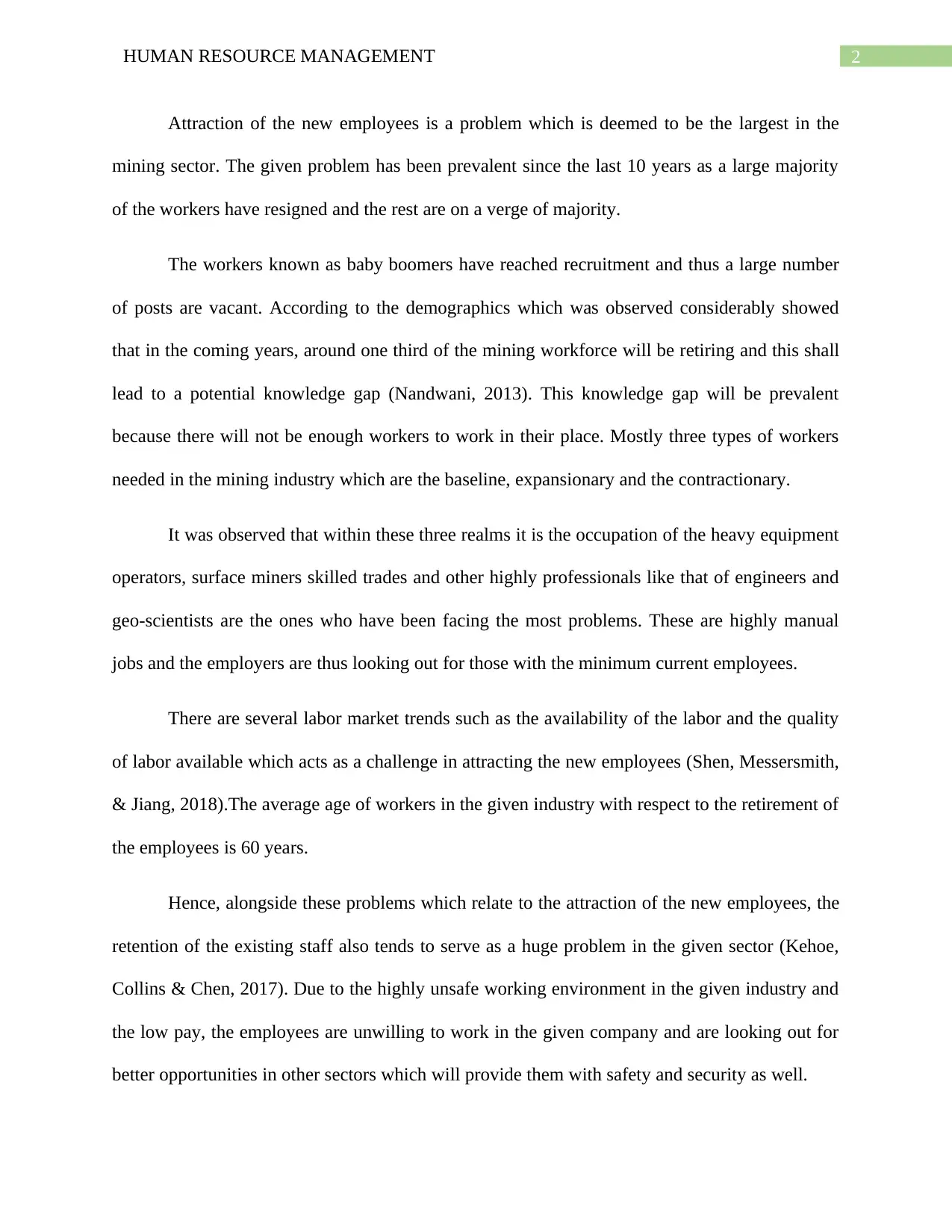
2HUMAN RESOURCE MANAGEMENT
Attraction of the new employees is a problem which is deemed to be the largest in the
mining sector. The given problem has been prevalent since the last 10 years as a large majority
of the workers have resigned and the rest are on a verge of majority.
The workers known as baby boomers have reached recruitment and thus a large number
of posts are vacant. According to the demographics which was observed considerably showed
that in the coming years, around one third of the mining workforce will be retiring and this shall
lead to a potential knowledge gap (Nandwani, 2013). This knowledge gap will be prevalent
because there will not be enough workers to work in their place. Mostly three types of workers
needed in the mining industry which are the baseline, expansionary and the contractionary.
It was observed that within these three realms it is the occupation of the heavy equipment
operators, surface miners skilled trades and other highly professionals like that of engineers and
geo-scientists are the ones who have been facing the most problems. These are highly manual
jobs and the employers are thus looking out for those with the minimum current employees.
There are several labor market trends such as the availability of the labor and the quality
of labor available which acts as a challenge in attracting the new employees (Shen, Messersmith,
& Jiang, 2018).The average age of workers in the given industry with respect to the retirement of
the employees is 60 years.
Hence, alongside these problems which relate to the attraction of the new employees, the
retention of the existing staff also tends to serve as a huge problem in the given sector (Kehoe,
Collins & Chen, 2017). Due to the highly unsafe working environment in the given industry and
the low pay, the employees are unwilling to work in the given company and are looking out for
better opportunities in other sectors which will provide them with safety and security as well.
Attraction of the new employees is a problem which is deemed to be the largest in the
mining sector. The given problem has been prevalent since the last 10 years as a large majority
of the workers have resigned and the rest are on a verge of majority.
The workers known as baby boomers have reached recruitment and thus a large number
of posts are vacant. According to the demographics which was observed considerably showed
that in the coming years, around one third of the mining workforce will be retiring and this shall
lead to a potential knowledge gap (Nandwani, 2013). This knowledge gap will be prevalent
because there will not be enough workers to work in their place. Mostly three types of workers
needed in the mining industry which are the baseline, expansionary and the contractionary.
It was observed that within these three realms it is the occupation of the heavy equipment
operators, surface miners skilled trades and other highly professionals like that of engineers and
geo-scientists are the ones who have been facing the most problems. These are highly manual
jobs and the employers are thus looking out for those with the minimum current employees.
There are several labor market trends such as the availability of the labor and the quality
of labor available which acts as a challenge in attracting the new employees (Shen, Messersmith,
& Jiang, 2018).The average age of workers in the given industry with respect to the retirement of
the employees is 60 years.
Hence, alongside these problems which relate to the attraction of the new employees, the
retention of the existing staff also tends to serve as a huge problem in the given sector (Kehoe,
Collins & Chen, 2017). Due to the highly unsafe working environment in the given industry and
the low pay, the employees are unwilling to work in the given company and are looking out for
better opportunities in other sectors which will provide them with safety and security as well.
⊘ This is a preview!⊘
Do you want full access?
Subscribe today to unlock all pages.

Trusted by 1+ million students worldwide
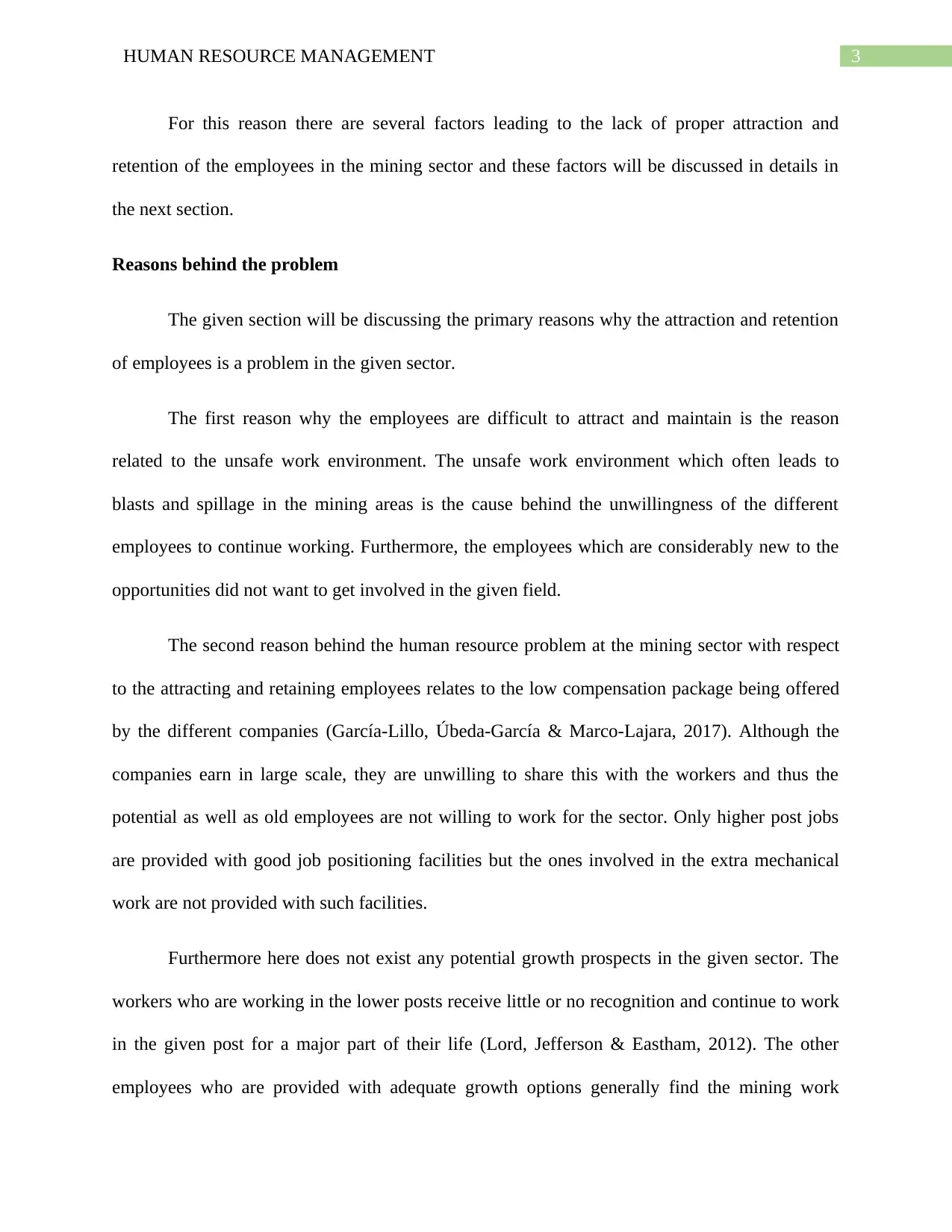
3HUMAN RESOURCE MANAGEMENT
For this reason there are several factors leading to the lack of proper attraction and
retention of the employees in the mining sector and these factors will be discussed in details in
the next section.
Reasons behind the problem
The given section will be discussing the primary reasons why the attraction and retention
of employees is a problem in the given sector.
The first reason why the employees are difficult to attract and maintain is the reason
related to the unsafe work environment. The unsafe work environment which often leads to
blasts and spillage in the mining areas is the cause behind the unwillingness of the different
employees to continue working. Furthermore, the employees which are considerably new to the
opportunities did not want to get involved in the given field.
The second reason behind the human resource problem at the mining sector with respect
to the attracting and retaining employees relates to the low compensation package being offered
by the different companies (García-Lillo, Úbeda-García & Marco-Lajara, 2017). Although the
companies earn in large scale, they are unwilling to share this with the workers and thus the
potential as well as old employees are not willing to work for the sector. Only higher post jobs
are provided with good job positioning facilities but the ones involved in the extra mechanical
work are not provided with such facilities.
Furthermore here does not exist any potential growth prospects in the given sector. The
workers who are working in the lower posts receive little or no recognition and continue to work
in the given post for a major part of their life (Lord, Jefferson & Eastham, 2012). The other
employees who are provided with adequate growth options generally find the mining work
For this reason there are several factors leading to the lack of proper attraction and
retention of the employees in the mining sector and these factors will be discussed in details in
the next section.
Reasons behind the problem
The given section will be discussing the primary reasons why the attraction and retention
of employees is a problem in the given sector.
The first reason why the employees are difficult to attract and maintain is the reason
related to the unsafe work environment. The unsafe work environment which often leads to
blasts and spillage in the mining areas is the cause behind the unwillingness of the different
employees to continue working. Furthermore, the employees which are considerably new to the
opportunities did not want to get involved in the given field.
The second reason behind the human resource problem at the mining sector with respect
to the attracting and retaining employees relates to the low compensation package being offered
by the different companies (García-Lillo, Úbeda-García & Marco-Lajara, 2017). Although the
companies earn in large scale, they are unwilling to share this with the workers and thus the
potential as well as old employees are not willing to work for the sector. Only higher post jobs
are provided with good job positioning facilities but the ones involved in the extra mechanical
work are not provided with such facilities.
Furthermore here does not exist any potential growth prospects in the given sector. The
workers who are working in the lower posts receive little or no recognition and continue to work
in the given post for a major part of their life (Lord, Jefferson & Eastham, 2012). The other
employees who are provided with adequate growth options generally find the mining work
Paraphrase This Document
Need a fresh take? Get an instant paraphrase of this document with our AI Paraphraser
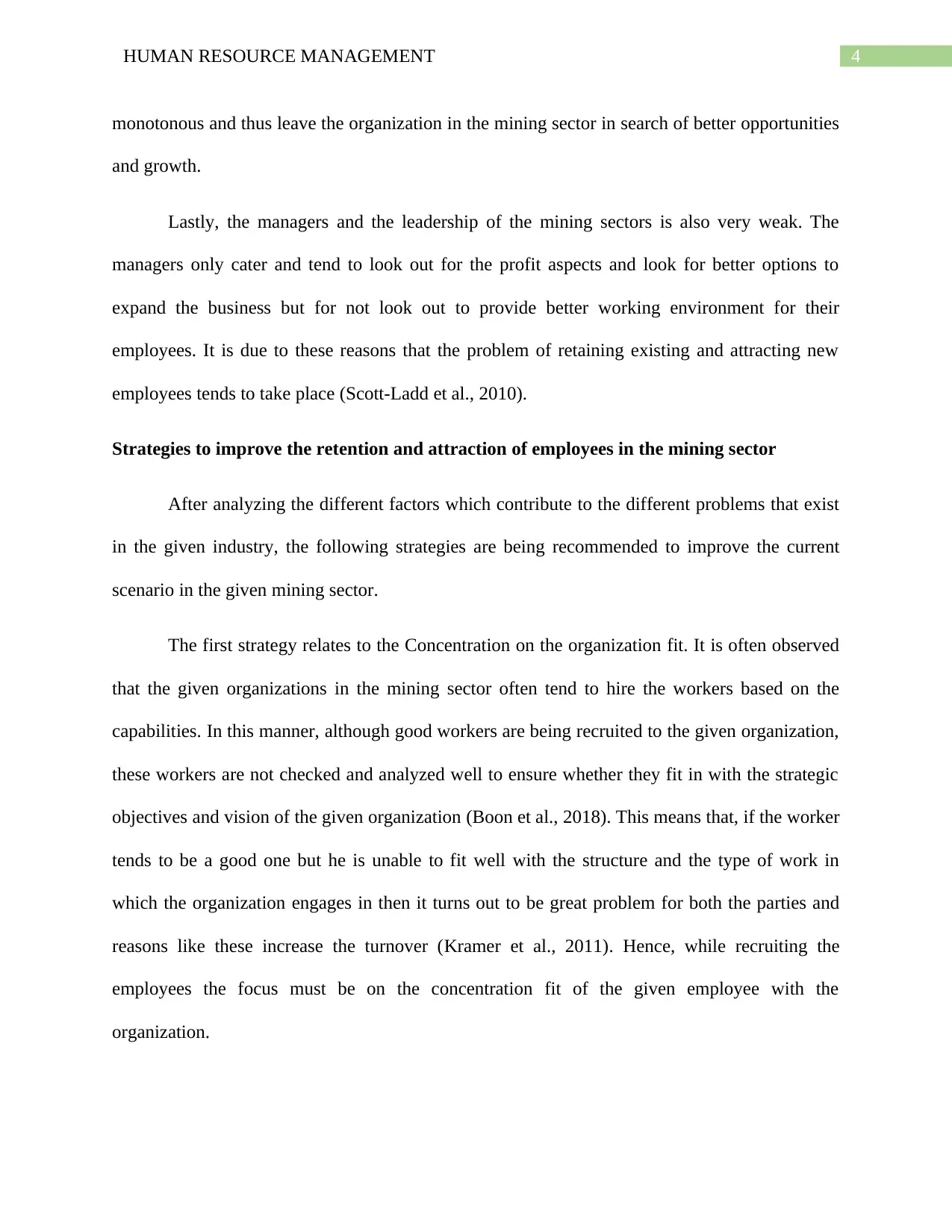
4HUMAN RESOURCE MANAGEMENT
monotonous and thus leave the organization in the mining sector in search of better opportunities
and growth.
Lastly, the managers and the leadership of the mining sectors is also very weak. The
managers only cater and tend to look out for the profit aspects and look for better options to
expand the business but for not look out to provide better working environment for their
employees. It is due to these reasons that the problem of retaining existing and attracting new
employees tends to take place (Scott-Ladd et al., 2010).
Strategies to improve the retention and attraction of employees in the mining sector
After analyzing the different factors which contribute to the different problems that exist
in the given industry, the following strategies are being recommended to improve the current
scenario in the given mining sector.
The first strategy relates to the Concentration on the organization fit. It is often observed
that the given organizations in the mining sector often tend to hire the workers based on the
capabilities. In this manner, although good workers are being recruited to the given organization,
these workers are not checked and analyzed well to ensure whether they fit in with the strategic
objectives and vision of the given organization (Boon et al., 2018). This means that, if the worker
tends to be a good one but he is unable to fit well with the structure and the type of work in
which the organization engages in then it turns out to be great problem for both the parties and
reasons like these increase the turnover (Kramer et al., 2011). Hence, while recruiting the
employees the focus must be on the concentration fit of the given employee with the
organization.
monotonous and thus leave the organization in the mining sector in search of better opportunities
and growth.
Lastly, the managers and the leadership of the mining sectors is also very weak. The
managers only cater and tend to look out for the profit aspects and look for better options to
expand the business but for not look out to provide better working environment for their
employees. It is due to these reasons that the problem of retaining existing and attracting new
employees tends to take place (Scott-Ladd et al., 2010).
Strategies to improve the retention and attraction of employees in the mining sector
After analyzing the different factors which contribute to the different problems that exist
in the given industry, the following strategies are being recommended to improve the current
scenario in the given mining sector.
The first strategy relates to the Concentration on the organization fit. It is often observed
that the given organizations in the mining sector often tend to hire the workers based on the
capabilities. In this manner, although good workers are being recruited to the given organization,
these workers are not checked and analyzed well to ensure whether they fit in with the strategic
objectives and vision of the given organization (Boon et al., 2018). This means that, if the worker
tends to be a good one but he is unable to fit well with the structure and the type of work in
which the organization engages in then it turns out to be great problem for both the parties and
reasons like these increase the turnover (Kramer et al., 2011). Hence, while recruiting the
employees the focus must be on the concentration fit of the given employee with the
organization.
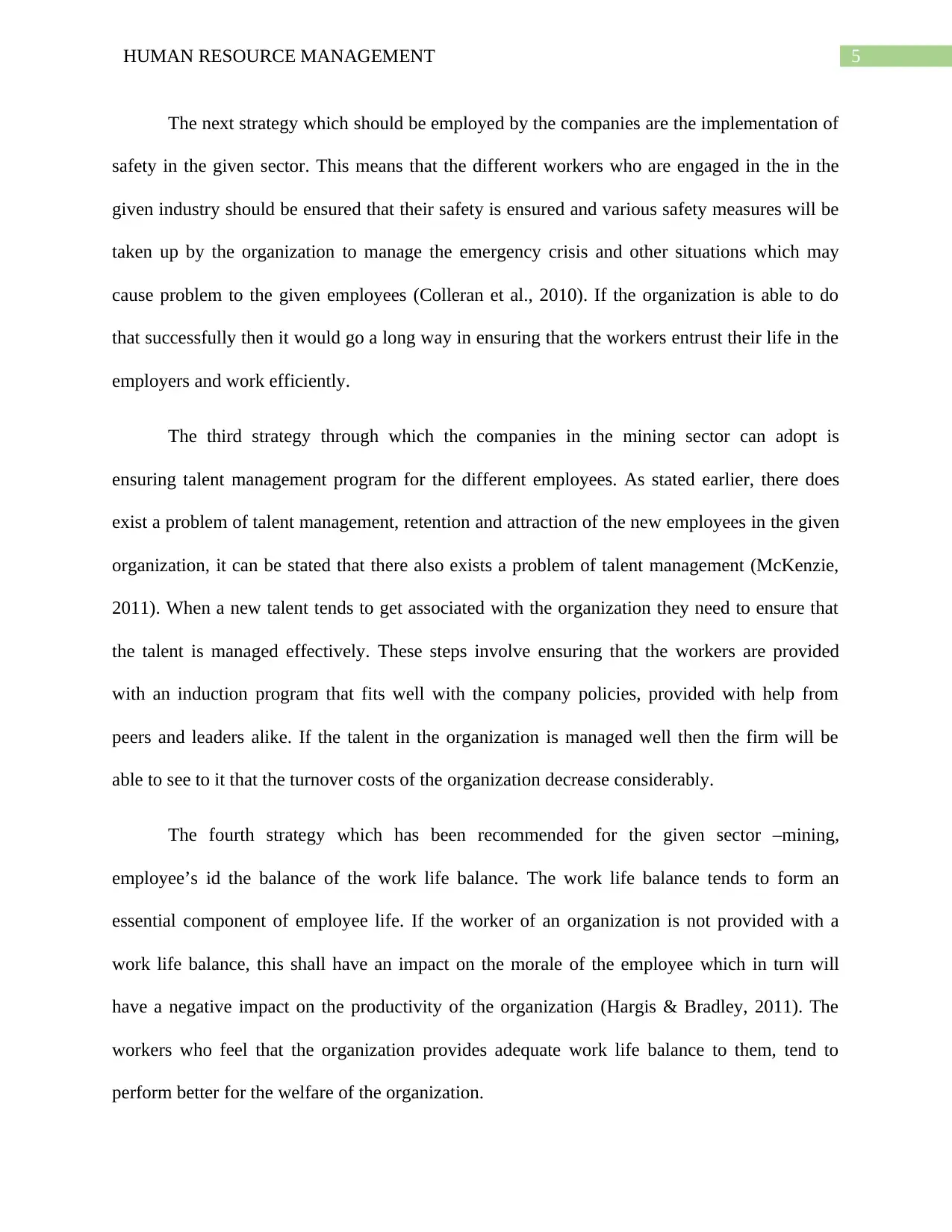
5HUMAN RESOURCE MANAGEMENT
The next strategy which should be employed by the companies are the implementation of
safety in the given sector. This means that the different workers who are engaged in the in the
given industry should be ensured that their safety is ensured and various safety measures will be
taken up by the organization to manage the emergency crisis and other situations which may
cause problem to the given employees (Colleran et al., 2010). If the organization is able to do
that successfully then it would go a long way in ensuring that the workers entrust their life in the
employers and work efficiently.
The third strategy through which the companies in the mining sector can adopt is
ensuring talent management program for the different employees. As stated earlier, there does
exist a problem of talent management, retention and attraction of the new employees in the given
organization, it can be stated that there also exists a problem of talent management (McKenzie,
2011). When a new talent tends to get associated with the organization they need to ensure that
the talent is managed effectively. These steps involve ensuring that the workers are provided
with an induction program that fits well with the company policies, provided with help from
peers and leaders alike. If the talent in the organization is managed well then the firm will be
able to see to it that the turnover costs of the organization decrease considerably.
The fourth strategy which has been recommended for the given sector –mining,
employee’s id the balance of the work life balance. The work life balance tends to form an
essential component of employee life. If the worker of an organization is not provided with a
work life balance, this shall have an impact on the morale of the employee which in turn will
have a negative impact on the productivity of the organization (Hargis & Bradley, 2011). The
workers who feel that the organization provides adequate work life balance to them, tend to
perform better for the welfare of the organization.
The next strategy which should be employed by the companies are the implementation of
safety in the given sector. This means that the different workers who are engaged in the in the
given industry should be ensured that their safety is ensured and various safety measures will be
taken up by the organization to manage the emergency crisis and other situations which may
cause problem to the given employees (Colleran et al., 2010). If the organization is able to do
that successfully then it would go a long way in ensuring that the workers entrust their life in the
employers and work efficiently.
The third strategy through which the companies in the mining sector can adopt is
ensuring talent management program for the different employees. As stated earlier, there does
exist a problem of talent management, retention and attraction of the new employees in the given
organization, it can be stated that there also exists a problem of talent management (McKenzie,
2011). When a new talent tends to get associated with the organization they need to ensure that
the talent is managed effectively. These steps involve ensuring that the workers are provided
with an induction program that fits well with the company policies, provided with help from
peers and leaders alike. If the talent in the organization is managed well then the firm will be
able to see to it that the turnover costs of the organization decrease considerably.
The fourth strategy which has been recommended for the given sector –mining,
employee’s id the balance of the work life balance. The work life balance tends to form an
essential component of employee life. If the worker of an organization is not provided with a
work life balance, this shall have an impact on the morale of the employee which in turn will
have a negative impact on the productivity of the organization (Hargis & Bradley, 2011). The
workers who feel that the organization provides adequate work life balance to them, tend to
perform better for the welfare of the organization.
⊘ This is a preview!⊘
Do you want full access?
Subscribe today to unlock all pages.

Trusted by 1+ million students worldwide
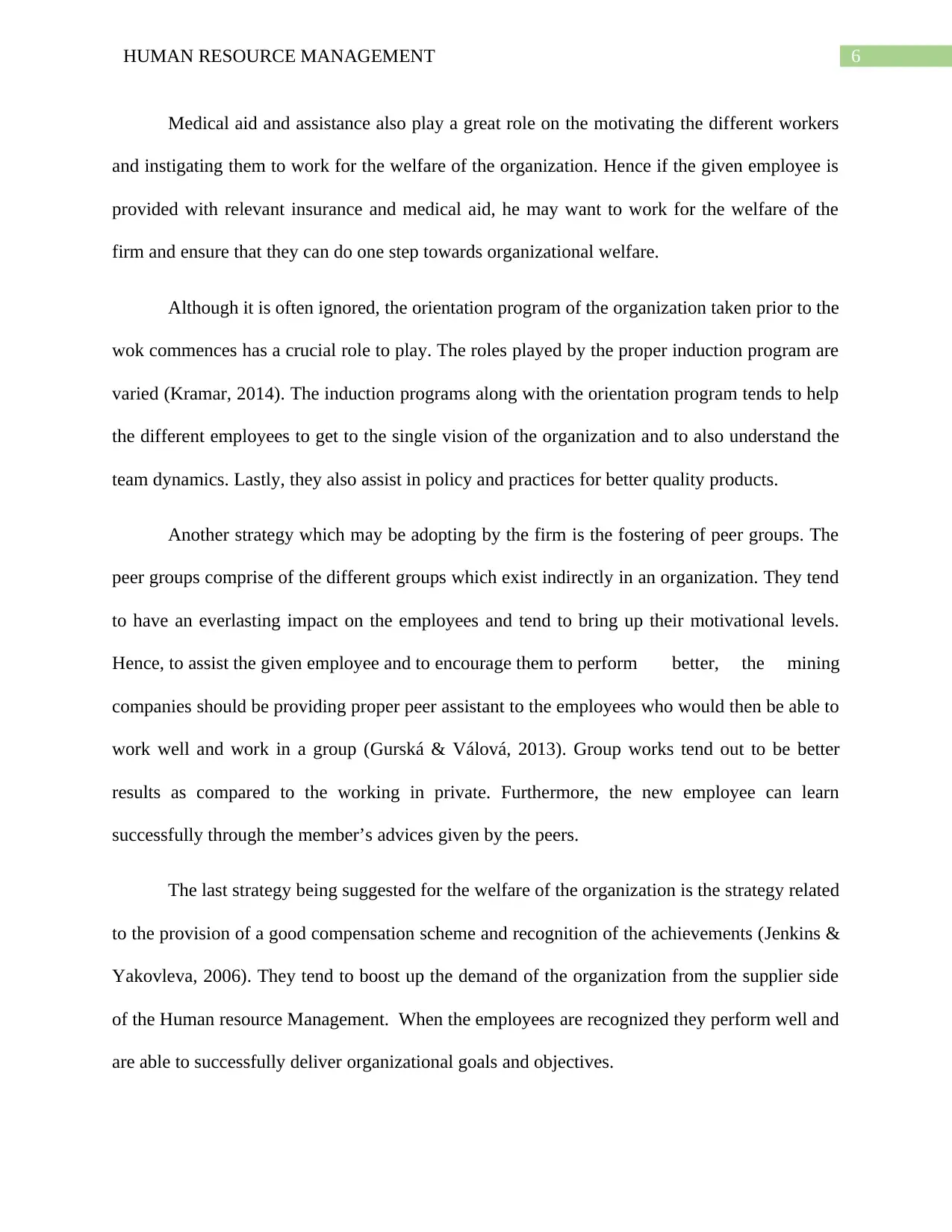
6HUMAN RESOURCE MANAGEMENT
Medical aid and assistance also play a great role on the motivating the different workers
and instigating them to work for the welfare of the organization. Hence if the given employee is
provided with relevant insurance and medical aid, he may want to work for the welfare of the
firm and ensure that they can do one step towards organizational welfare.
Although it is often ignored, the orientation program of the organization taken prior to the
wok commences has a crucial role to play. The roles played by the proper induction program are
varied (Kramar, 2014). The induction programs along with the orientation program tends to help
the different employees to get to the single vision of the organization and to also understand the
team dynamics. Lastly, they also assist in policy and practices for better quality products.
Another strategy which may be adopting by the firm is the fostering of peer groups. The
peer groups comprise of the different groups which exist indirectly in an organization. They tend
to have an everlasting impact on the employees and tend to bring up their motivational levels.
Hence, to assist the given employee and to encourage them to perform better, the mining
companies should be providing proper peer assistant to the employees who would then be able to
work well and work in a group (Gurská & Válová, 2013). Group works tend out to be better
results as compared to the working in private. Furthermore, the new employee can learn
successfully through the member’s advices given by the peers.
The last strategy being suggested for the welfare of the organization is the strategy related
to the provision of a good compensation scheme and recognition of the achievements (Jenkins &
Yakovleva, 2006). They tend to boost up the demand of the organization from the supplier side
of the Human resource Management. When the employees are recognized they perform well and
are able to successfully deliver organizational goals and objectives.
Medical aid and assistance also play a great role on the motivating the different workers
and instigating them to work for the welfare of the organization. Hence if the given employee is
provided with relevant insurance and medical aid, he may want to work for the welfare of the
firm and ensure that they can do one step towards organizational welfare.
Although it is often ignored, the orientation program of the organization taken prior to the
wok commences has a crucial role to play. The roles played by the proper induction program are
varied (Kramar, 2014). The induction programs along with the orientation program tends to help
the different employees to get to the single vision of the organization and to also understand the
team dynamics. Lastly, they also assist in policy and practices for better quality products.
Another strategy which may be adopting by the firm is the fostering of peer groups. The
peer groups comprise of the different groups which exist indirectly in an organization. They tend
to have an everlasting impact on the employees and tend to bring up their motivational levels.
Hence, to assist the given employee and to encourage them to perform better, the mining
companies should be providing proper peer assistant to the employees who would then be able to
work well and work in a group (Gurská & Válová, 2013). Group works tend out to be better
results as compared to the working in private. Furthermore, the new employee can learn
successfully through the member’s advices given by the peers.
The last strategy being suggested for the welfare of the organization is the strategy related
to the provision of a good compensation scheme and recognition of the achievements (Jenkins &
Yakovleva, 2006). They tend to boost up the demand of the organization from the supplier side
of the Human resource Management. When the employees are recognized they perform well and
are able to successfully deliver organizational goals and objectives.
Paraphrase This Document
Need a fresh take? Get an instant paraphrase of this document with our AI Paraphraser
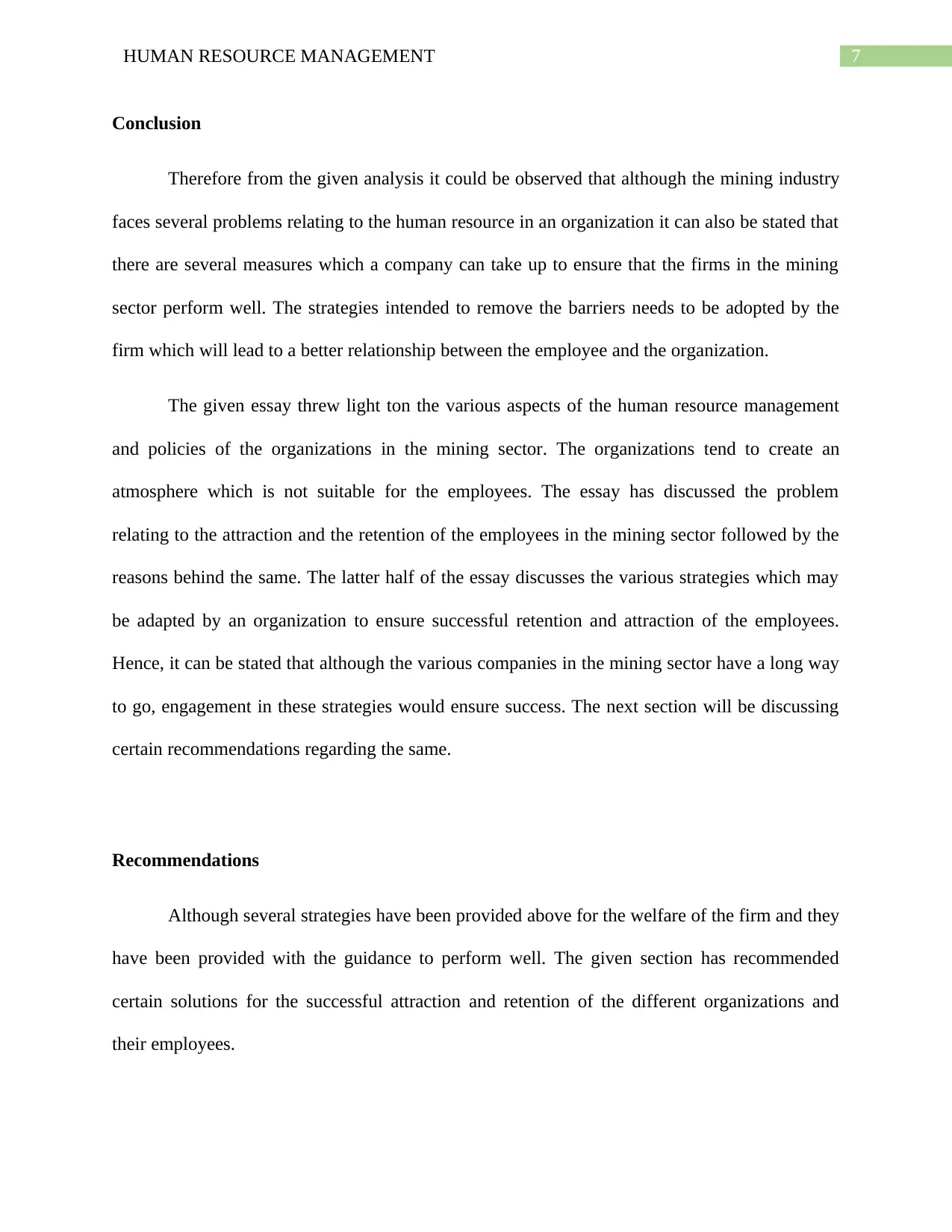
7HUMAN RESOURCE MANAGEMENT
Conclusion
Therefore from the given analysis it could be observed that although the mining industry
faces several problems relating to the human resource in an organization it can also be stated that
there are several measures which a company can take up to ensure that the firms in the mining
sector perform well. The strategies intended to remove the barriers needs to be adopted by the
firm which will lead to a better relationship between the employee and the organization.
The given essay threw light ton the various aspects of the human resource management
and policies of the organizations in the mining sector. The organizations tend to create an
atmosphere which is not suitable for the employees. The essay has discussed the problem
relating to the attraction and the retention of the employees in the mining sector followed by the
reasons behind the same. The latter half of the essay discusses the various strategies which may
be adapted by an organization to ensure successful retention and attraction of the employees.
Hence, it can be stated that although the various companies in the mining sector have a long way
to go, engagement in these strategies would ensure success. The next section will be discussing
certain recommendations regarding the same.
Recommendations
Although several strategies have been provided above for the welfare of the firm and they
have been provided with the guidance to perform well. The given section has recommended
certain solutions for the successful attraction and retention of the different organizations and
their employees.
Conclusion
Therefore from the given analysis it could be observed that although the mining industry
faces several problems relating to the human resource in an organization it can also be stated that
there are several measures which a company can take up to ensure that the firms in the mining
sector perform well. The strategies intended to remove the barriers needs to be adopted by the
firm which will lead to a better relationship between the employee and the organization.
The given essay threw light ton the various aspects of the human resource management
and policies of the organizations in the mining sector. The organizations tend to create an
atmosphere which is not suitable for the employees. The essay has discussed the problem
relating to the attraction and the retention of the employees in the mining sector followed by the
reasons behind the same. The latter half of the essay discusses the various strategies which may
be adapted by an organization to ensure successful retention and attraction of the employees.
Hence, it can be stated that although the various companies in the mining sector have a long way
to go, engagement in these strategies would ensure success. The next section will be discussing
certain recommendations regarding the same.
Recommendations
Although several strategies have been provided above for the welfare of the firm and they
have been provided with the guidance to perform well. The given section has recommended
certain solutions for the successful attraction and retention of the different organizations and
their employees.
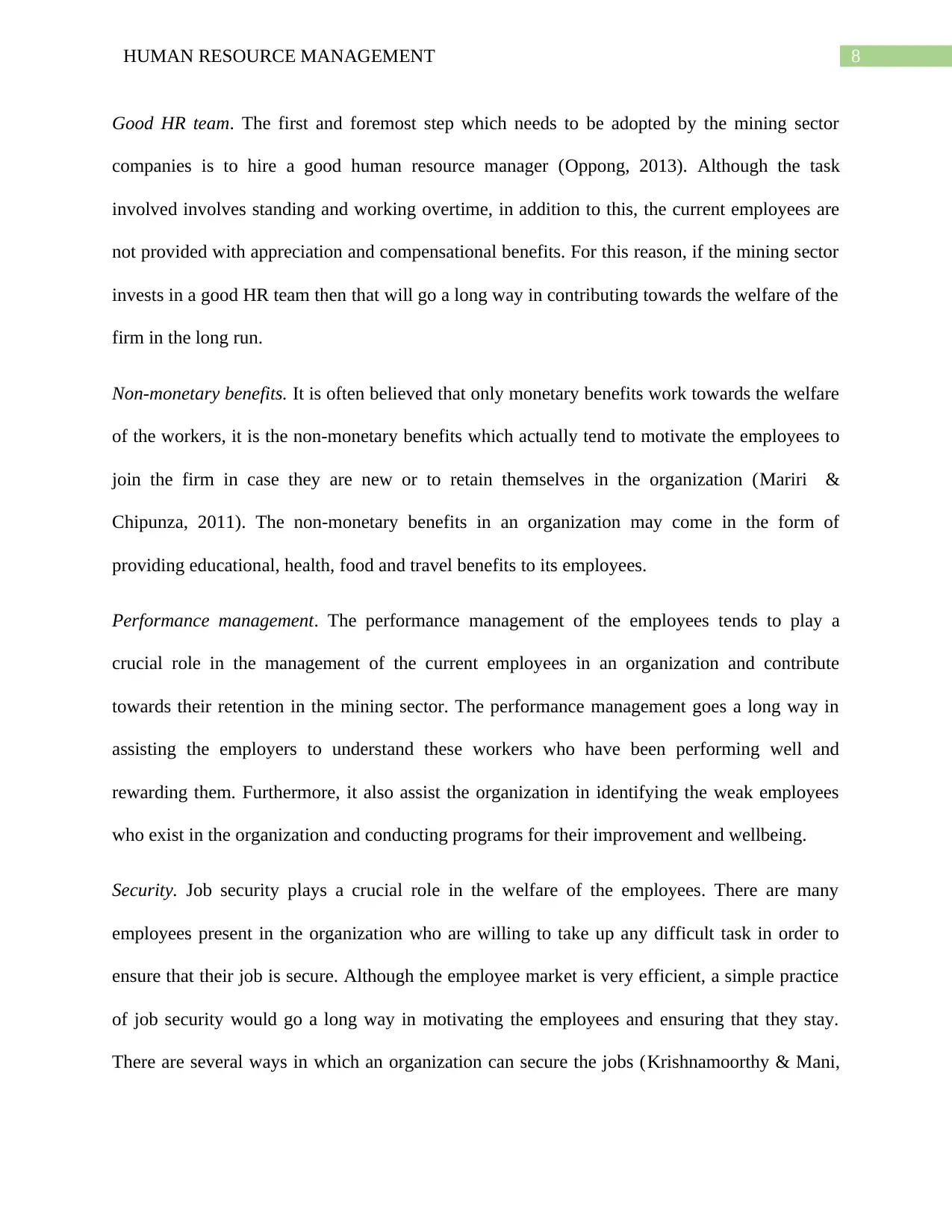
8HUMAN RESOURCE MANAGEMENT
Good HR team. The first and foremost step which needs to be adopted by the mining sector
companies is to hire a good human resource manager (Oppong, 2013). Although the task
involved involves standing and working overtime, in addition to this, the current employees are
not provided with appreciation and compensational benefits. For this reason, if the mining sector
invests in a good HR team then that will go a long way in contributing towards the welfare of the
firm in the long run.
Non-monetary benefits. It is often believed that only monetary benefits work towards the welfare
of the workers, it is the non-monetary benefits which actually tend to motivate the employees to
join the firm in case they are new or to retain themselves in the organization (Mariri &
Chipunza, 2011). The non-monetary benefits in an organization may come in the form of
providing educational, health, food and travel benefits to its employees.
Performance management. The performance management of the employees tends to play a
crucial role in the management of the current employees in an organization and contribute
towards their retention in the mining sector. The performance management goes a long way in
assisting the employers to understand these workers who have been performing well and
rewarding them. Furthermore, it also assist the organization in identifying the weak employees
who exist in the organization and conducting programs for their improvement and wellbeing.
Security. Job security plays a crucial role in the welfare of the employees. There are many
employees present in the organization who are willing to take up any difficult task in order to
ensure that their job is secure. Although the employee market is very efficient, a simple practice
of job security would go a long way in motivating the employees and ensuring that they stay.
There are several ways in which an organization can secure the jobs (Krishnamoorthy & Mani,
Good HR team. The first and foremost step which needs to be adopted by the mining sector
companies is to hire a good human resource manager (Oppong, 2013). Although the task
involved involves standing and working overtime, in addition to this, the current employees are
not provided with appreciation and compensational benefits. For this reason, if the mining sector
invests in a good HR team then that will go a long way in contributing towards the welfare of the
firm in the long run.
Non-monetary benefits. It is often believed that only monetary benefits work towards the welfare
of the workers, it is the non-monetary benefits which actually tend to motivate the employees to
join the firm in case they are new or to retain themselves in the organization (Mariri &
Chipunza, 2011). The non-monetary benefits in an organization may come in the form of
providing educational, health, food and travel benefits to its employees.
Performance management. The performance management of the employees tends to play a
crucial role in the management of the current employees in an organization and contribute
towards their retention in the mining sector. The performance management goes a long way in
assisting the employers to understand these workers who have been performing well and
rewarding them. Furthermore, it also assist the organization in identifying the weak employees
who exist in the organization and conducting programs for their improvement and wellbeing.
Security. Job security plays a crucial role in the welfare of the employees. There are many
employees present in the organization who are willing to take up any difficult task in order to
ensure that their job is secure. Although the employee market is very efficient, a simple practice
of job security would go a long way in motivating the employees and ensuring that they stay.
There are several ways in which an organization can secure the jobs (Krishnamoorthy & Mani,
⊘ This is a preview!⊘
Do you want full access?
Subscribe today to unlock all pages.

Trusted by 1+ million students worldwide
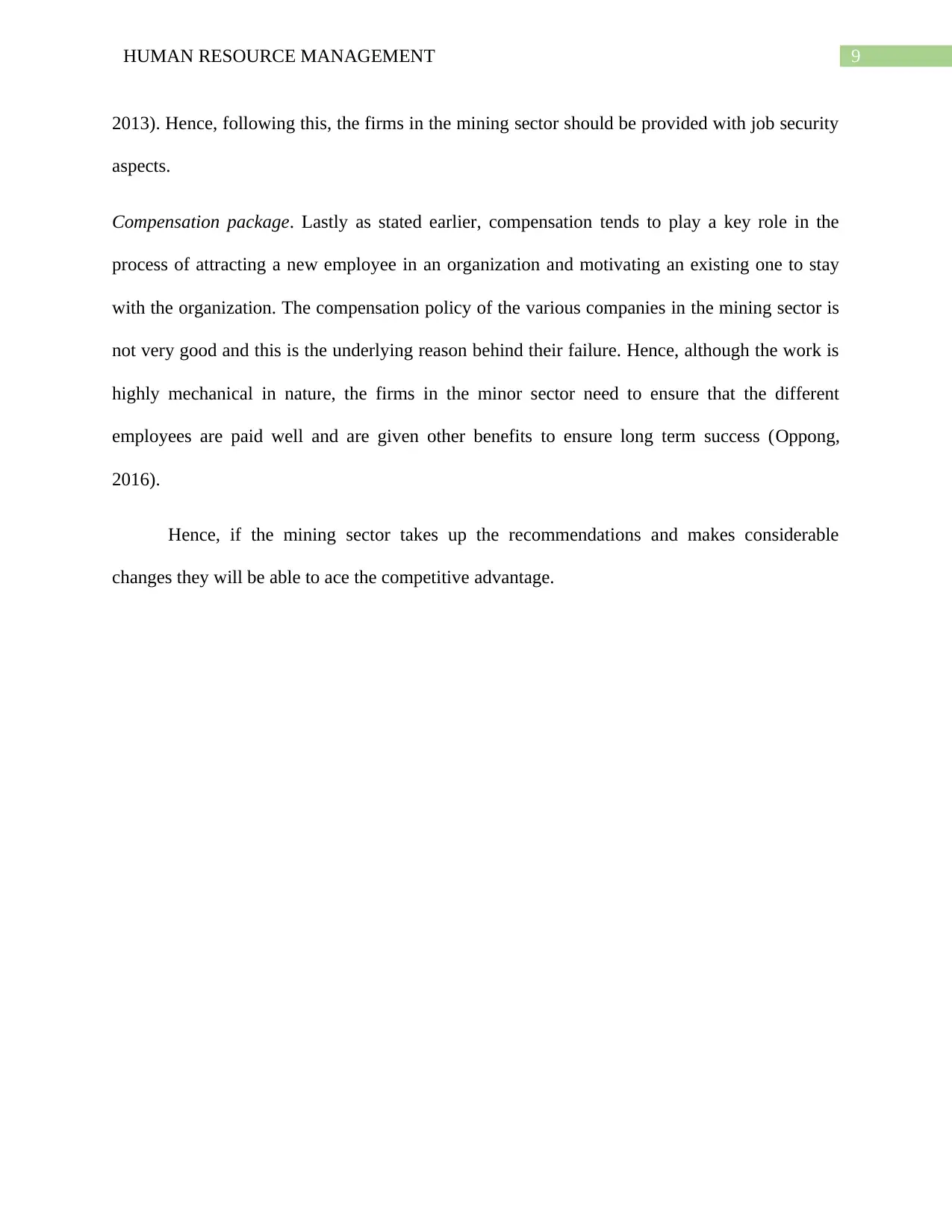
9HUMAN RESOURCE MANAGEMENT
2013). Hence, following this, the firms in the mining sector should be provided with job security
aspects.
Compensation package. Lastly as stated earlier, compensation tends to play a key role in the
process of attracting a new employee in an organization and motivating an existing one to stay
with the organization. The compensation policy of the various companies in the mining sector is
not very good and this is the underlying reason behind their failure. Hence, although the work is
highly mechanical in nature, the firms in the minor sector need to ensure that the different
employees are paid well and are given other benefits to ensure long term success (Oppong,
2016).
Hence, if the mining sector takes up the recommendations and makes considerable
changes they will be able to ace the competitive advantage.
2013). Hence, following this, the firms in the mining sector should be provided with job security
aspects.
Compensation package. Lastly as stated earlier, compensation tends to play a key role in the
process of attracting a new employee in an organization and motivating an existing one to stay
with the organization. The compensation policy of the various companies in the mining sector is
not very good and this is the underlying reason behind their failure. Hence, although the work is
highly mechanical in nature, the firms in the minor sector need to ensure that the different
employees are paid well and are given other benefits to ensure long term success (Oppong,
2016).
Hence, if the mining sector takes up the recommendations and makes considerable
changes they will be able to ace the competitive advantage.
Paraphrase This Document
Need a fresh take? Get an instant paraphrase of this document with our AI Paraphraser
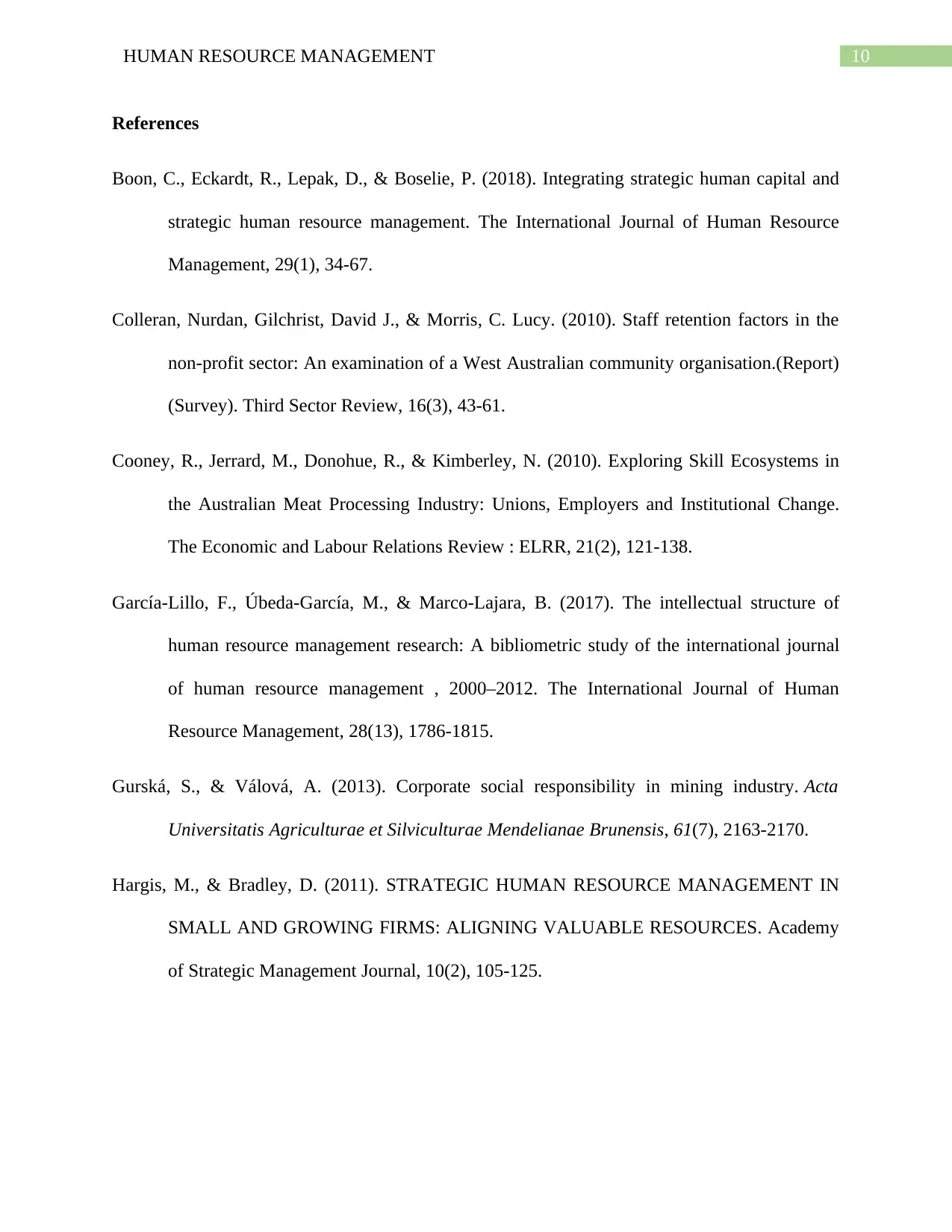
10HUMAN RESOURCE MANAGEMENT
References
Boon, C., Eckardt, R., Lepak, D., & Boselie, P. (2018). Integrating strategic human capital and
strategic human resource management. The International Journal of Human Resource
Management, 29(1), 34-67.
Colleran, Nurdan, Gilchrist, David J., & Morris, C. Lucy. (2010). Staff retention factors in the
non-profit sector: An examination of a West Australian community organisation.(Report)
(Survey). Third Sector Review, 16(3), 43-61.
Cooney, R., Jerrard, M., Donohue, R., & Kimberley, N. (2010). Exploring Skill Ecosystems in
the Australian Meat Processing Industry: Unions, Employers and Institutional Change.
The Economic and Labour Relations Review : ELRR, 21(2), 121-138.
García-Lillo, F., Úbeda-García, M., & Marco-Lajara, B. (2017). The intellectual structure of
human resource management research: A bibliometric study of the international journal
of human resource management , 2000–2012. The International Journal of Human
Resource Management, 28(13), 1786-1815.
Gurská, S., & Válová, A. (2013). Corporate social responsibility in mining industry. Acta
Universitatis Agriculturae et Silviculturae Mendelianae Brunensis, 61(7), 2163-2170.
Hargis, M., & Bradley, D. (2011). STRATEGIC HUMAN RESOURCE MANAGEMENT IN
SMALL AND GROWING FIRMS: ALIGNING VALUABLE RESOURCES. Academy
of Strategic Management Journal, 10(2), 105-125.
References
Boon, C., Eckardt, R., Lepak, D., & Boselie, P. (2018). Integrating strategic human capital and
strategic human resource management. The International Journal of Human Resource
Management, 29(1), 34-67.
Colleran, Nurdan, Gilchrist, David J., & Morris, C. Lucy. (2010). Staff retention factors in the
non-profit sector: An examination of a West Australian community organisation.(Report)
(Survey). Third Sector Review, 16(3), 43-61.
Cooney, R., Jerrard, M., Donohue, R., & Kimberley, N. (2010). Exploring Skill Ecosystems in
the Australian Meat Processing Industry: Unions, Employers and Institutional Change.
The Economic and Labour Relations Review : ELRR, 21(2), 121-138.
García-Lillo, F., Úbeda-García, M., & Marco-Lajara, B. (2017). The intellectual structure of
human resource management research: A bibliometric study of the international journal
of human resource management , 2000–2012. The International Journal of Human
Resource Management, 28(13), 1786-1815.
Gurská, S., & Válová, A. (2013). Corporate social responsibility in mining industry. Acta
Universitatis Agriculturae et Silviculturae Mendelianae Brunensis, 61(7), 2163-2170.
Hargis, M., & Bradley, D. (2011). STRATEGIC HUMAN RESOURCE MANAGEMENT IN
SMALL AND GROWING FIRMS: ALIGNING VALUABLE RESOURCES. Academy
of Strategic Management Journal, 10(2), 105-125.
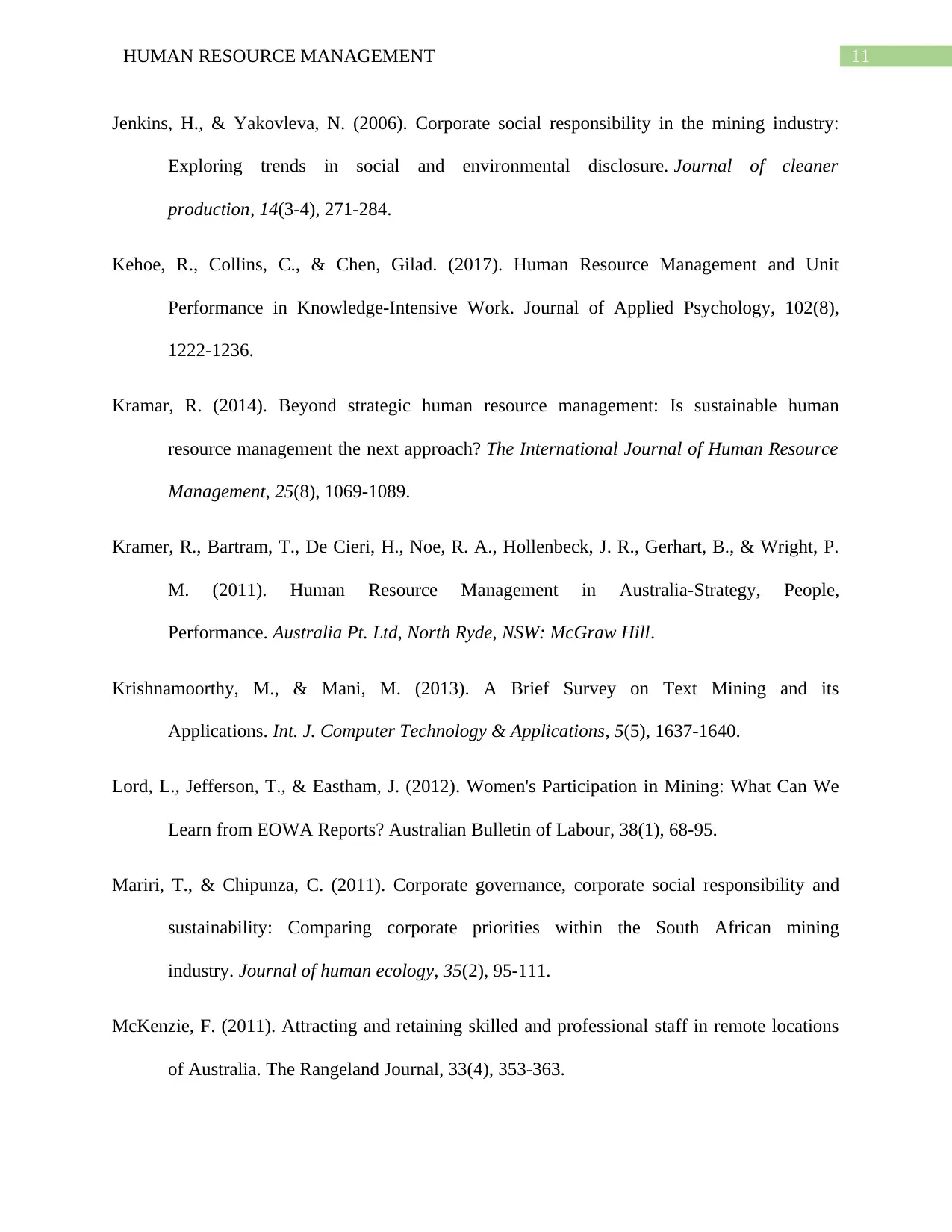
11HUMAN RESOURCE MANAGEMENT
Jenkins, H., & Yakovleva, N. (2006). Corporate social responsibility in the mining industry:
Exploring trends in social and environmental disclosure. Journal of cleaner
production, 14(3-4), 271-284.
Kehoe, R., Collins, C., & Chen, Gilad. (2017). Human Resource Management and Unit
Performance in Knowledge-Intensive Work. Journal of Applied Psychology, 102(8),
1222-1236.
Kramar, R. (2014). Beyond strategic human resource management: Is sustainable human
resource management the next approach? The International Journal of Human Resource
Management, 25(8), 1069-1089.
Kramer, R., Bartram, T., De Cieri, H., Noe, R. A., Hollenbeck, J. R., Gerhart, B., & Wright, P.
M. (2011). Human Resource Management in Australia-Strategy, People,
Performance. Australia Pt. Ltd, North Ryde, NSW: McGraw Hill.
Krishnamoorthy, M., & Mani, M. (2013). A Brief Survey on Text Mining and its
Applications. Int. J. Computer Technology & Applications, 5(5), 1637-1640.
Lord, L., Jefferson, T., & Eastham, J. (2012). Women's Participation in Mining: What Can We
Learn from EOWA Reports? Australian Bulletin of Labour, 38(1), 68-95.
Mariri, T., & Chipunza, C. (2011). Corporate governance, corporate social responsibility and
sustainability: Comparing corporate priorities within the South African mining
industry. Journal of human ecology, 35(2), 95-111.
McKenzie, F. (2011). Attracting and retaining skilled and professional staff in remote locations
of Australia. The Rangeland Journal, 33(4), 353-363.
Jenkins, H., & Yakovleva, N. (2006). Corporate social responsibility in the mining industry:
Exploring trends in social and environmental disclosure. Journal of cleaner
production, 14(3-4), 271-284.
Kehoe, R., Collins, C., & Chen, Gilad. (2017). Human Resource Management and Unit
Performance in Knowledge-Intensive Work. Journal of Applied Psychology, 102(8),
1222-1236.
Kramar, R. (2014). Beyond strategic human resource management: Is sustainable human
resource management the next approach? The International Journal of Human Resource
Management, 25(8), 1069-1089.
Kramer, R., Bartram, T., De Cieri, H., Noe, R. A., Hollenbeck, J. R., Gerhart, B., & Wright, P.
M. (2011). Human Resource Management in Australia-Strategy, People,
Performance. Australia Pt. Ltd, North Ryde, NSW: McGraw Hill.
Krishnamoorthy, M., & Mani, M. (2013). A Brief Survey on Text Mining and its
Applications. Int. J. Computer Technology & Applications, 5(5), 1637-1640.
Lord, L., Jefferson, T., & Eastham, J. (2012). Women's Participation in Mining: What Can We
Learn from EOWA Reports? Australian Bulletin of Labour, 38(1), 68-95.
Mariri, T., & Chipunza, C. (2011). Corporate governance, corporate social responsibility and
sustainability: Comparing corporate priorities within the South African mining
industry. Journal of human ecology, 35(2), 95-111.
McKenzie, F. (2011). Attracting and retaining skilled and professional staff in remote locations
of Australia. The Rangeland Journal, 33(4), 353-363.
⊘ This is a preview!⊘
Do you want full access?
Subscribe today to unlock all pages.

Trusted by 1+ million students worldwide
1 out of 13
Related Documents
Your All-in-One AI-Powered Toolkit for Academic Success.
+13062052269
info@desklib.com
Available 24*7 on WhatsApp / Email
![[object Object]](/_next/static/media/star-bottom.7253800d.svg)
Unlock your academic potential
Copyright © 2020–2025 A2Z Services. All Rights Reserved. Developed and managed by ZUCOL.





